Sail Race Flags: Their Significance and Use
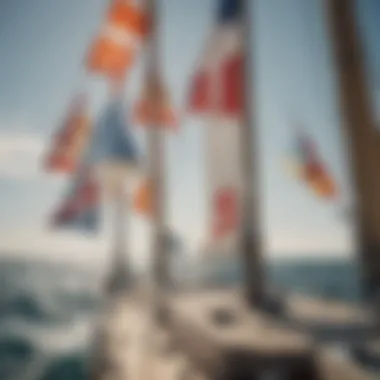
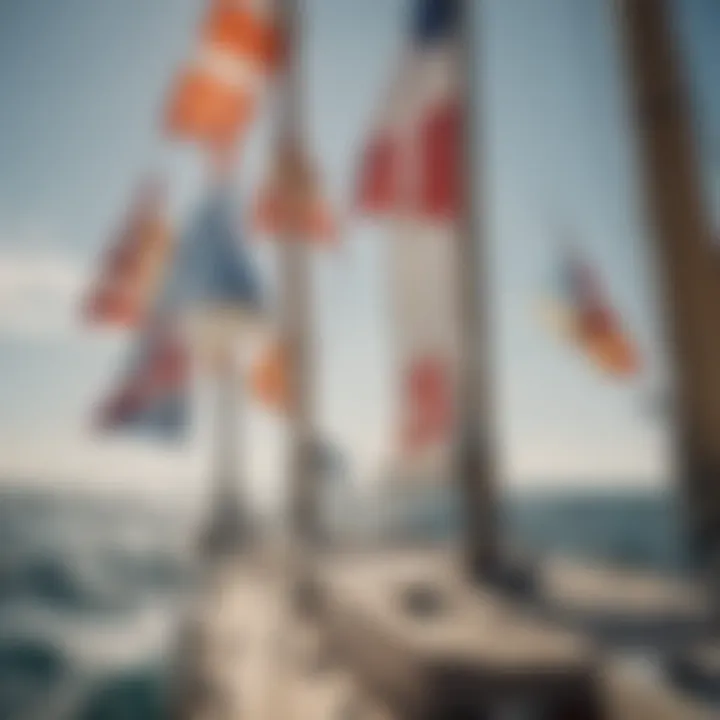
Intro
In the competitive realm of yacht racing, sail race flags are not just colorful pieces of fabric hoisted high; they are vital tools that convey critical messages and rules. Their significance runs deep, steeped in maritime tradition and etiquette, providing clarity and a common language amongst sailors on the water. Understanding these flags isn't just about knowing the meanings; it involves grasping their origin and how they shape the racing experience for novices and seasoned sailors alike.
From the simple signal indicating a race start to warnings about potentially hazardous conditions, each flag has a purpose and historical context that speaks to the evolution of maritime practices. This exploration reveals not only the practical applications of sail race flags but also their intertwined relationship with competitive sailing etiquette that governs interactions on the water. For those who partake in the sport, recognizing the nuances of these signals can elevate their experience and enhance their performance.
The journey through the world of sail race flags will unfold in several key areas. First, it will delve into the essential techniques and skills every sailor should cultivate to interpret and utilize these flags effectively. Following this, we will examine the essential equipment and gear that plays a role in ensuring smooth communication during races, culminating in a comprehensive synthesis of the insights garnered through this exploration. Readers, whether they are aspiring sailors or experienced competitors, will find a wealth of knowledge and practical advice throughout this guide.
The History of Sail Race Flags
The evolution of sail race flags is not just about patterns and colors; it’s a narrative that intertwines maritime culture, communication, and competition. Understanding the history behind these flags gives us a glimpse into how seafarers have communicated crucial information on the open waters for centuries. Each flag tells a story, a significance that transcends mere decoration. It stands as a testament to the tradition and rules that govern yacht racing, reminding sailors and enthusiasts alike of their shared heritage and the importance of precision and clarity in maritime communication.
Origin of Racing Flags
The roots of sail race flags can be traced back to the early days of naval warfare and fishing. Originally, flags served as a means for vessels to identify themselves or their intentions, similar to today but with a more survival-oriented motive. In simpler times, sailors often relied on various colored cloths to convey messages to one another. Historians have noted that these early signals were akin to a game of charades played at sea, where a misinterpretation could lead to dire consequences.
For instance, the color red has long been associated with danger, a concept that quickly took root among sailors. Both fishing boats and warships used a variety of banners to communicate their status. Flags signaling safe passage, threats, or even trades laid the groundwork for what would become a more structured form of communication.
Over time — moving through the ages of exploration and into the world of competitive sailing — the practice of using flags became codified. The transition from a crude system to one that adhered to an established set of rules marked a significant step in the sport. The need to standardize these signals became apparent as more vessels began participating in organized racing, leading to the first formal definitions of racing flags.
Evolution Over Time
As time rolled on, the multitude of colors and flags used expanded substantially. Each flag began to represent specific commands or information, developing a lexicon of its own. Different countries began adopting individual flags, and the codes were often drawn from nautical customs passed from generation to generation.
In the early 20th century, it became evident that there was a need for international standardization as sailing became popular worldwide. The International Code of Signals established a common understanding, thus minimizing confusion among sailors from different regions. This code brought uniformity to the flags used during races, ensuring that all competitors, regardless of their sailing background, could understand and react to the signals being communicated.
Some notable flags that evolved during this time included the First Substitute and the Preparatory flags. The systematic approach replacing the haphazard methods of the past represents a significant leap forward in marine communication. This evolution also mirrors technological advancements in other areas, reflecting a growing desire for better safety and clearer communication on the high seas.
Understanding the history of sail race flags is foundational. Realizing their role in communication enhances the appreciation for today’s complex competitions. As we dive deeper into their purposes and the various types, the evolution paints a clearer picture, one where sailors across generations sought to inform, adjust, and ultimately triumph on the water.
The Purpose of Sail Race Flags
The realm of sail racing encompasses not only the thrill of competition but also requires precise communication and adherence to established protocols. Sail race flags serve as crucial tools in this environment, embodying both authority and information flowing through the air and across the waters. Understanding their purpose is not just about knowing what each flag means; it’s about grasping their role in ensuring order, safety, and clarity during races.
Communication at Sea
Effective communication is the bedrock of any successful sail race. At sea, where the winds roar and waves crash, verbal announcements can easily become lost. In this context, flags emerge as visual signals, transcending language barriers and providing instantaneous information to all competitors.
Imagine a sailboat slicing through the waves. Skippers rely on the vivid display of flags to relay vital messages regarding race status, course changes, and other important notifications. Each flag carries its own meaning, from signaling the start of a race to alerting sailors about adverse conditions. Here are a few key functions:
- Start Signs: Flags indicate the countdown to the race, establishing the right moment for a sprint.
- Signals for Readiness: A green flag may suggest that competitors can proceed, while a red flag warns of danger.
- Course Modifications: Flags can communicate changes in the race course, ensuring everyone is on the same page.
"In competitive sailing, clarity is not optional; it's essential. Each flag's display can shift the fate of those competing on water."
This communication becomes especially critical in large events where numerous boats are present. The colors and shapes of flags become a shared language, allowing sailors to respond promptly and accurately.
Race Regulation and Protocol
Beyond facilitating communication, sail race flags are integral to maintaining order and enforcing the rules of the game. Each race has a governing body that sets forth regulations, ensuring that competitors abide by the same standards and maintain a fair playing field. This is where flags come into play.
Every race committee utilizes flags in specific contexts to communicate regulatory measures. Their presence on the water serves as reminders of the rules that govern fair play. Important aspects include:
- Disqualification Flags: Certain flags indicate foul play. If a competitor breaches a rule, they might see a flag raised, signaling their disqualification. This quick and visible form of regulation can deter misconduct.
- Protest Flags: If competitors have grievances regarding another's behavior, they can signal their intent to protest using designated flags. This is critical in maintaining integrity within the sport.
- Weather Alerts: Flags also communicate vital information regarding weather changes that could impact race conditions, enabling teams to adjust strategies swiftly.
By integrating flag communication into their race strategies, sailors can uphold etiquette while focusing on their performance. Understanding and respecting the protocols behind these flags is essential for any sailor aiming to compete successfully and ethically in the world of sail racing.
In sum, the purpose of sail race flags extends beyond mere decoration. They bind competitors together through established communication and uphold the integrity of the sport, making them indispensable in every sail race.
Standard Flags Used in Sail Racing
In sail racing, flags are more than just colorful pieces of fabric; they play a critical role in communication and regulation on the water. Understanding the standard flags used in racing not only enhances a competitor’s awareness of the race dynamics but also enriches the experience of spectators and participants alike. Each flag comes with its own set of meanings and signals, making them essential tools for effective maritime interactions.
The Start Signal Flags
Start signal flags are perhaps the most pivotal elements in the arsenal of race communication. Sail racing is often described as a dance of precision and timing, where every second counts. The right flags set the stage for this ballet, indicating when competitors can make their move. There are specific flags designated for the starting sequence:
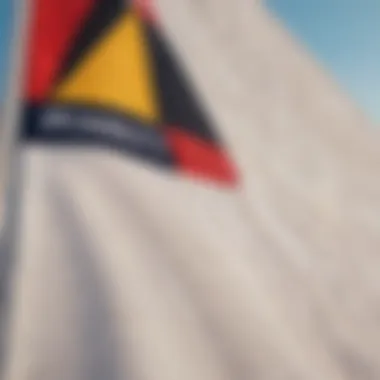

- The Preparatory Flag (P Flag): This blue flag signals competitors to get ready for the start sequence. It’s crucial during the initial moments before the race, allowing sailors to fine-tune their positions without the pressure of immediate action.
- The Starting Flag (First Substitution Flag): Once the time comes, the starting flag drops, and it’s game on. It signifies that racers can commence their journey, and any misstep can lead to an unfair advantage for some competitors.
This clarity given by the start flags helps level the playing field, ensuring that all boats have a fair shot when the signal is given. Missing these flags can not only lead to confusion but can also negatively impact the results of the race, making their importance quite clear.
Flags Indicating Course Changes
As the race progresses, changes in the course can occur due to various factors, such as wind conditions or safety concerns. Flags indicating these changes are vital for keeping sailors informed and prepared. The two key flags in this category include:
- Course Change Flag (Numeral Flag): Usually a numeral pennant, this flag tells competitors of a shift in the designated course. This flag often requires keen eyesight and prompt action, as each numeral corresponds to a different set of navigation instructions.
- Mark Change Flag: This flag signals modifications to the position of the marks themselves. It is critical that sailors react swiftly, adjusting their tactics to maintain optimal racing positions.
Understanding these signals is like having a cheat sheet for navigating dynamic courses. Misinterpretations here can lead to significant penalties or losing crucial placements, making the vigilance demanded by these flags unsurpassed.
Flags for Disqualifications
In the competitive world of sail racing, integrity plays a significant role. To uphold standards, disqualification flags serve as important reminders to adhere to the rules. When waves of competition whirl together, it’s easy to veer off the path. The flags indicating disqualifications include:
- Black Flag: This flag carries a clear message: if it’s raised, it signifies that a competitor is disqualified. This is often due to infractions or violations of race rules, acted upon swiftly to maintain fairness throughout the event.
- Red Flag: While it can indicate danger or extreme caution in many contexts, in sail racing, it also serves as a warning. It can imply that a competitor has failed to comply with the regulations and must adjust their actions accordingly or face penalties.
Facilitating a fair trading ground, these flags challenge competitors to adhere to their principles. They serve as both a motivation and a cautionary signal that racing is as much about sportsmanship as speed.
"The flags serve as the conductors in the orchestra of sail racing, ensuring that each note is played flawlessly, harmonizing communication and competition."
Understanding the significance of standard flags used in sail racing is akin to grasping the language of the sea, each pattern and hue holding an essential narrative that affects every participant on the water.
Color Coding and Flag Types
Understanding the color coding and types of flags used in sailing is crucial for both competitors and enthusiasts. The ability to quickly interpret these visual signals can mean the difference between success and failure in competitive sailing environments. Colors not only convey important information but also serve as identifiers for specific types of messages communicated during races.
Meaning of Specific Colors
In the realm of sail racing, color carries significant weight. Each hue can represent various commands, statuses, or warnings. For instance, a glaring red flag might scream danger or disqualification, while a vibrant green can signify that all is clear and competitors can proceed. Knowing the meanings behind these colors allows sailors to respond accordingly, ensuring they remain in compliance with race protocols.
Here are some notable examples of colors and what they usually mean:
- Red: Indicates disqualification or a race cancellation.
- Green: Signifies that the racer is allowed to start or continue.
- Yellow: Often used for general warnings or notifications about changing conditions.
- Blue: Frequently represents a stop or the need to slow down.
Grasping these color cues fosters better communication, helping sailors navigate races with precision and agility. It’s not just about interpretation but also about reacting swiftly, often when conditions become chaotic.
Different Types of Flags
Flags come in various shapes, sizes, and uses that fit the specific needs of sail racing. Their diversity reflects the different types of information that need to be communicated.
Numerical Flags
Numerical flags serve a distinct purpose in sail racing. Each swatch displays a number, which corresponds to a pre-defined meaning in racing contexts. For instance, a flag with the numeral 1 often indicates a particular race course or a signal to start the race a specific way.
The key characteristic of numerical flags is their straightforward representational approach. This makes them popular among competitors who appreciate clarity. The beneficial aspect of using numerical flags is their direct correlation to specific announcements or instructions, leaving little to chance regarding interpretation.
However, one should note that these flags typically require a sailor to have prior knowledge of the meanings assigned to each number. While they are effective, their successful use relies heavily on familiarization, which could lead to confusion for newcomers.
Signal Flags
Signal flags, on the other hand, carry broader meanings and are more versatile than numerical ones. These flags often indicate instructions or warnings and can be used for a variety of purposes throughout a competition. For instance, the “P” flag signals that a postponement is in effect, while the “L” flag may mean a low wind condition has been declared.
The unique feature of signal flags is their ability to convey a range of messages through a limited number of symbols. This adaptability makes them a popular choice in sail racing, as they can communicate urgent information succinctly. Their use promotes efficiency amongst competitors, who often encounter quick changes during races.
However, similar to numerical flags, their interpretation requires knowledge of the flag signaling system. If a competitor is not versed in what each signal flag means, the implications may lead to mistakes during a crucial moment in a race. Learning about both numerical and signal flags through practice or guided instruction is imperative for success in the sailing world.
"Mastering the meanings of flags in sailing isn’t just an exercise in memorization; it’s an essential component of effective racing strategy."
In sum, understanding color coding and the diverse types of flags enriches sailors' experience and enhances their performance during races. By being versed in these visual cues and their meanings, sailors can ensure effective communication on the water—all vital for mastering the complexities of competitive sailing.
International Flag Code
The International Flag Code holds significant importance in the context of sail race flags, serving as a universal framework for communication among sailors across the globe. This code provides clarity and standardization, which is vital in a sport that can often be chaotic and misunderstood. Understanding it is not just beneficial; it’s essential for maintaining order and ensuring that essential messages are conveyed swiftly and accurately. The code consists of flags that represent letters, numbers, and specific signals, thus forming a communication system that navigators can rely on.
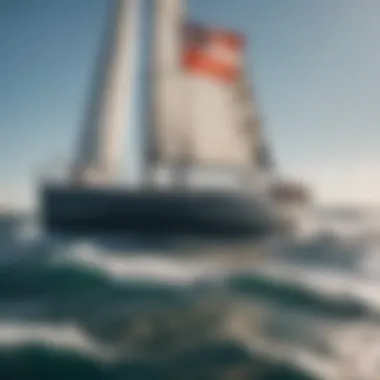
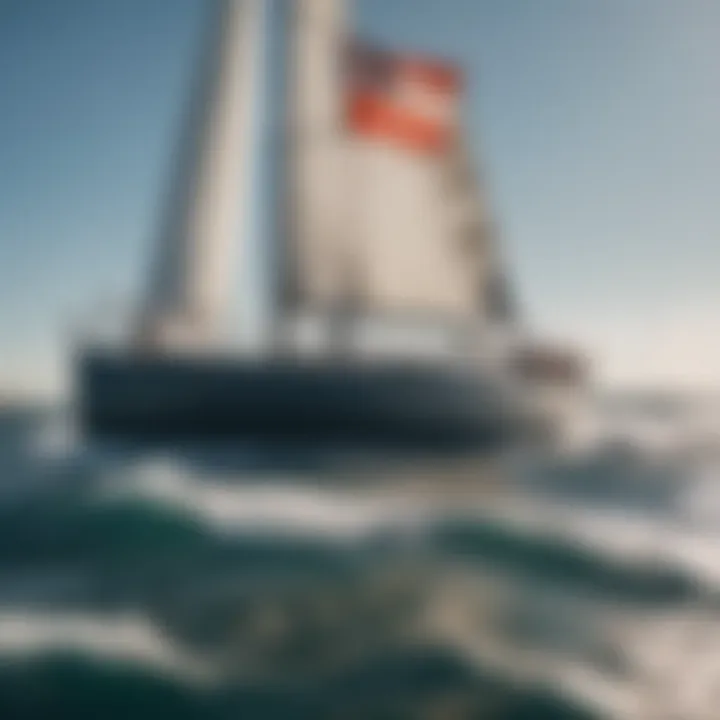
Overview of the Code
At its core, the International Flag Code utilizes a set of colored flags, each standing for a letter in the alphabet or a numeral. For instance, the Alfa flag, which is a blue and white flag, denotes the letter "A". When displayed, it signals diver down; do not approach. Each flag has its own distinct meaning, which adds a layer of depth and complexity to this method of communication. Understanding every flag’s significance not only empowers sailors to relay messages but also to interpret information from race committees or fellow competitors.
To paint the picture further:
- Flags can be hoisted individually or in combination, leading to a plethora of meanings.
- A combination of flags can even convey specific instructions related to races, including course changes or penalties.
- Wrong interpretation of flags can lead to miscommunication, potentially compromising safety and the race's integrity.
Application in Competitive Sailing
In the competitive sailing arena, the International Flag Code is crucial. Competitors often find themselves maneuvering in high-stakes environments where clear communication is key to success. Failure to comprehend or notice a flag could lead to serious consequences, such as disqualification or, more importantly, safety risks.
During sail races, race committees utilize flags to communicate with sailors efficiently. Here’s how this system plays out in real-world racing scenarios:
- Start Signals: The starting sequences often incorporate specific flags to indicate when a race is about to commence. Misreading these could mean missing the starting line, putting a boat at a disadvantage right from the get-go.
- Penalties: Certain flags can indicate penalties to boats, notably the Flag U, which signals an individual recall when a competitor starts prematurely. Understanding these flags helps sailors adjust quickly to avoid further sanctions.
- Race Modifications: Flags such as the Course Change flag, when displayed, relay vital changes in the race course, requiring sailors to remain vigilant and responsive to such alterations.
"A sailor's skill is not only pilots the vessel but also interprets the language of flags—and in competitive sailing, that language is the International Flag Code."
In summary, the International Flag Code acts as the backbone of communication in competitive sailing. With a firm grasp of this code, sailors engage in races more strategically, minimizing risks and maximizing their performance. Understanding these flags is indispensable for anyone looking to excel in the racing world. More than just a set of colors, these flags represent a language of the sea.
Flags and Their Representation in Sailing Etiquette
When it comes to the competitive sailing scene, flags do more than just wave in the breeze. They represent a set of values and unwritten rules that are critical for maintaining harmony on the water. Understanding the nuances of flag etiquette is not just about following orders; it's about respecting the spirit of the challenge and the fellow competitors. These flags hold deep meanings that extend beyond their fabrics, embodying respect, tradition, and the commitment to fair play.
Respecting Race Committee Flags
Respect for race committee flags is paramount in setting the stage for a fair race. Each flag displayed by the race committee is a silent command that calls for immediate attention. Ignoring these flags can lead to misunderstandings that may disrupt the race. Live by this principle: If you see a flag from the committee, treat it like a traffic signal—it could change the course of your race.
For instance, the "Start Flag" (usually an orange one) is a clear indication that preparations for the race are underway. On the other hand, flags indicating a delay or general recall can be equally important. Competitors need to be alert to these signals to avoid unnecessary penalties.
Flag respect also extends to the recognition of who is displaying them. Often, these flags come with a duty of responsibility. Racers must understand that the committee members are tasked with enforcing the rules fairly and justly. When there's a dismissal of these flags, it not only shows disrespect but creates chaos on the water, distorting the competition. Clear communication through flags fosters an environment where everyone competes on a level playing field.
Flag Etiquette During Races
During races, maintaining proper flag etiquette reflects a sailor's dedication to sportsmanship. Flags serve not merely as communicative tools, but as symbols of trust among participants. Adhering to their meanings is crucial; after all, in the spirit of competition, clarity can prevent disputes.
Here’s what you should keep in mind:
- Stay Aware: Always be conscious of the flags being flown by your competitors. It’s good practice to familiarize yourself with flag meanings before setting sail.
- Respond Promptly: Responding to flag signals without delay is fundamental. A quick reaction can be the difference between leading and lagging.
- Team Consistency: In team competitions, uniform understanding of flag meanings and responses can influence the team's performance. Discuss procedures before race day.
"A well-orchestrated sail race runs much like a finely tuned orchestra; if one musician misses their cue, the symphony falters."
Remember that etiquette doesn’t merely lie in following orders. It encompasses demonstrating courtesy, acknowledging the rules, and respecting both competitors and organizers. The sailing community thrives on these virtues, fostering relationships built on shared goals and the collective love for the sport. Implementing solid flag protocols not only improves individual racing experiences but honors the collective spirit of sailing.
In closing, the relationship between flags and etiquette is integral to the culture surrounding competitive sailing. When every sailor respects the flags and their meanings, they contribute to a race that is not only competitive but also respectful and enjoyable for everyone involved.
Common Mistakes with Sail Race Flags
Understanding common mistakes in the use of sail race flags is pivotal for both novice and seasoned sailors. Flags serve as vital communication tools on the water, enabling competitors to understand intentions, rules, and changes quickly. When errors occur in their interpretation or usage, it can lead to confusion, frustration, and sometimes even disqualification. Therefore, clarity on these mistakes not only enhances racing efficiency but also bolsters the competitive spirit.
Misinterpretations and Confusions
One of the most prevalent issues sailors face revolves around misinterpretations of flags. It’s not uncommon for a sailor to mistake a warning flag for a start signal, or to misread the flags indicating course changes.
These errors can stem from several factors:
- Experience Level: Newer competitors may not have had the time to familiarize themselves with every flag and its specifics. They might glance at a flag and instinctively react, rather than pausing to confirm its meaning.
- Visibility Conditions: Weather can play a huge role in how well flags can be seen and understood. High winds or heavy rain can obscure visibility, leading to misinterpretation.
- Stressful Environments: Race situations can be tense. Under pressure, even the most seasoned sailor can misinterpret what they see.
The consequences of misreading flags can be severe, affecting race outcomes directly. A single mistake may compromise a competitor's standings, leading to disputes or, in extreme cases, penalties. Thus, maintaining awareness and understanding the flags is essential for maintaining fair competition.
Inconsistent Usage Among Competitors
Another critical area of concern is the inconsistent usage of flags among different competitors. This inconsistency arises when sailors do not adhere to standard regulations or mix personal interpretations with established protocols.
- Local Variations: Some sailing communities or clubs may have local customs that differ from international standards, which can lead to confusion during races involving diverse fleets.
- Lack of Training: Sailors who have not undergone formal training often rely on hearsay or their interpretation of flag meanings. This leads to varying practices, whereby one sailor’s understanding may drastically differ from another’s.
- Passing the Buck: In team events or relay races, if one sailor fails to communicate effectively about expected flag signals, their teammates can be left scrambling, jeopardizing their collective performance.


To combat these inconsistencies, it’s imperative for sailors to engage in ongoing education, both in formal settings and through group discussions. Practical drills, workshops, and even peer-to-peer reviews can foster a stronger understanding of flag signification, encouraging uniformly accepted practices among all competitors.
"Consistent communication and understanding of sail race flags can not only enhance performance but also enrich the overall spirit of competition."
Sail racing relies heavily on clear communication, and misconceptions stemming from flag usage can lead to a breakdown in this essential aspect. Being aware of the potential for misunderstanding and taking proactive measures to mitigate these risks can be the difference between sailing success and failure.
Special Flags in Sailing Events
In the world of competitive sailing, flags serve purposes far beyond mere decoration. Special flags play pivotal roles in signaling unique circumstances during races. These flags not only communicate essential information but also enrich the narrative of maritime competition. Their significance cannot be understated, as they reflect the values of safety, respect, and camaraderie among sailors.
Flags for Special Circumstances
Sailboat races aren't just about mastering the wind; sometimes they require special signals to address unexpected situations. Flags used for special circumstances can vary greatly, and knowing them might just save a race from going awry. For instance, a red flag might indicate a serious hazard on the course, signaling competitors to be vigilant.
When a race has been postponed due to weather or some other reason, a flag with a yellow background often does the trick. It lets sailors know they're in a holding pattern, and to not stray too far from the start line.
Here's a rundown of some common special circumstance flags:
- Red Flag: Signals a danger or something serious that requires immediate caution.
- Yellow Flag: Used to denote a delay or postponement in the race schedule.
- Black Flag: This flag tells sailors that a disqualification notice is imminent for ongoing rule violations.
Understanding these flags is crucial. Ignoring them could lead to miscommunication, resulting in a less-than-ideal performance or even disqualification. A sailor needs to remain sharp, keeping an eye on both the course and the flags waving in the wind.
Celebratory and Commemorative Flags
Beyond the race itself, flags also embody the spirit of celebration and remembrance in the sailing community. Celebratory flags can be a sight to behold, transforming any maritime gathering into a vibrant spectacle. Whether it's a local club's annual regatta or an international competition, these flags mark achievements and milestones within the sailing ranks.
Commemorative flags serve to honor individuals or events that have made significant impact on sailing. A classic example is the flag raised during a memorial race, which pays tribute to a sailor who was lost at sea.
These flags often feature specific designs, colors, and symbols that evoke specific emotions or memories. Each flag raises the spirits of those involved, reminding them of shared traditions and shared goals. Some key points concerning celebratory and commemorative flags include:
- Design: Often personalized to reflect the event or honor the individual.
- Usage: Raised alongside others during significant events, playing a vital role in creating a festive atmosphere.
- Traditions: Many clubs or fleets have their own nuances regarding how and when to display these flags.
"The blues and whites of the flags ripple through the air, capturing the essence of joyous moments and solemn remembrances—a testament to the passion of those at sea."
In essence, special flags in sailing aren't just pieces of fabric; they're rich in meaning and history. By acknowledging their purpose, sailors can navigate both the waters of competition and the waters of tradition and celebration, fostering a strong bond within the community.
Technological Advancements in Flag Communication
The world of sail racing has always been one of tradition and legacy, but that doesn't mean it has to be stuck in the past. As technology progresses, so too does the method of communicating crucial information between ships and race officials. The integration of modern tech into flag communication has brought both efficiency and clarity, enhancing the overall racing experience.
Digital Communication in Sailing
In today’s fast-paced environment, digital technology has made its mark on sail racing. Sailors and race officials no longer rely solely on physical flags for communication; they have turned their focus towards electronic means. The use of digital communication systems allows for faster and more accurate dissemination of information. This includes everything from race signals to real-time updates on course changes.
Digital displays positioned around the race area can relay the same messages that flags would. These screens might show countdowns to race starts, course adjustments, and even weather updates. By converting visual signals into digital formats, the chance of misinterpretation is significantly lowered. For instance, a sailor who's squinting into the sun won't miss a critical shift in racing strategy thanks to a brightly lit screen.
The Role of Mobile Apps
The rise of smartphones has revolutionized how sailors interact with race information. Specialized mobile applications serve as pocket-sized race boards, giving users access to their race committee updates and alerting them to any important changes, all from the palm of their hand. Apps like RaceQs and SailRaceWorld have made it easier for competitors to stay informed while out on the water.
Moreover, these applications can be programmed to provide notifications about flag signals, ensuring that even the most forgetful sailor stays in the loop. Some apps take it a step further; they allow users to customize notifications based on their preferences, which helps in managing the chaotic energy of race day.
The benefits of using these mobile applications are clear:
- Real-time updates: Sailors get instant information on race developments, which keeps everyone in sync.
- Historical data: These apps can store past races for analysis, helping competitors improve their strategies over time.
- Social features: Many sailing apps incorporate features that let users connect with friends and share experiences, fostering a sense of community among sailors.
End on the Role of Flags in Sail Racing
In the world of sail racing, flags play a role that extends beyond mere decoration; they serve as vital instruments of communication. The significance of flags is interwoven with the very fabric of competitive sailing—ensuring clarity, safety, and adherence to the rules of the race. All participants, from the race committee to the sailors themselves, rely on these flags for effective interaction amidst the aquatic expanse.
Summary of Key Points
- Historical Context: Flags have a rich history and are rooted in maritime tradition, evolving significantly over time to adapt to the needs of racing.
- Communication: Flags provide instantaneous visual cues that can change the course of a race, making clear essential information such as start signals, penalties, or course adjustments.
- Regulatory Importance: Sail race flags embody the rules and protocols inherent in competitive racing. They ensure that competitors respect and understand the regulations governing races to maintain safety and fair play.
- Etiquette and Respect: Understanding flags fosters a culture of respect among competitors and reinforces adherence to sailing etiquette. Knowing when to acknowledge certain flags, such as those from the race committee, can greatly influence the teamwork aspect on the water.
- Technological Integration: As sailing evolves, the incorporation of technology alongside flags shows how the sport is adapting to modern needs. Digital communications and mobile apps enhance understanding but do not replace the fundamental need for physical flags.
The Future of Sail Race Flags
Looking ahead, the future of sail race flags may evolve in unexpected directions. While the classic flags will remain essential, we could see changes influenced by the growing emphasis on technology in sports. The adoption of digital displays perhaps? Or apps that could replicate the messages of these flags while ensuring that everyone on a vessel is informed simultaneously.
It’s also likely that the colors and designs used in flags might become standardized across various races worldwide, promoting a more universal understanding among international competitors. Future flag designs could reflect sustainability, aligning with a broader push for environmental consciousness in sailing.
The importance of flags, however, will not diminish. Instead, they will continue to bridge tradition and innovation, creating a harmonious blend that represents the history and future of competitive sailing. Through conscientious observers and enthusiasts, the essence of what these flags symbolize will endure, fostering a rich culture that values respect, regulation, and communication.







